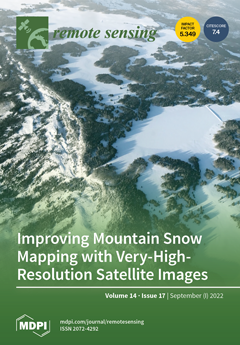Carbon dioxide (CO
2) is one of the main greenhouse gases leading to global warming, and the ocean is the largest carbon reservoir on the earth that plays an important role in regulating CO
2 concentration on a global scale. The column-averaged dry-air mole fraction of atmospheric CO
2 (XCO
2) is a key parameter in describing ocean carbon content. In this paper, the Data Interpolation Empirical Orthogonal Function (DINEOF) and the Bayesian Maximum Entropy (BME) methods are combined to interpolate XCO
2 data of Orbiting Carbon Observatory 2 (OCO-2) and Orbiting Carbon Observatory 3 (OCO-3) from January to December 2020 occurring within the geographical range of 15–45°N and 120–150°E. At the first stage of our proposed analysis, spatiotemporal information was used by the DINEOF method to perform XCO
2 interpolation that improved data coverage; at the second stage, the DINEOF-generated interpolation results were regarded as soft data and were subsequently assimilated using the BME method to obtain improved XCO
2 interpolation values. The performance of the synthetic DINEOF–BME interpolation method was evaluated by means of a five-fold cross-validation method. The results showed that the Mean Absolute Error (MAE), the Root Mean Square Error (RMSE), and the Bias of the DINEOF-based OCO-2 and OCO-3 interpolations were 2.106 ppm, 3.046 ppm, and 1.035 ppm, respectively. On the other hand, the MAE, RMSE, and Bias of the cross-validation results obtained by the DINEOF–BME were 1.285 ppm, 2.422 ppm, and −0.085 ppm, respectively, i.e., smaller than the results obtained by DINEOF. In addition, based on the in situ measured XCO
2 data provided by the Total Carbon Column Observing Network (TCCON), the original OCO-2 and OCO-3 data were combined and compared with the interpolated products of the synthetic DINEOF–BME framework. The accuracy of the original OCO-2 and OCO-3 products is lower than the DINEOF–BME-generated XCO
2 products in terms of MAE (1.751 ppm vs. 2.616 ppm), RMSE (2.877 ppm vs. 3.566 ppm) and Bias (1.379 ppm vs 1.622 ppm), the spatiotemporal coverage of XCO
2 product also improved dramatically from 16% to 100%. Lastly, this study demonstrated the feasibility of the synthetic DINEOF–BME approach for XCO
2 interpolation purposes and the ability of the BME method to be successfully combined with other techniques.
Full article





